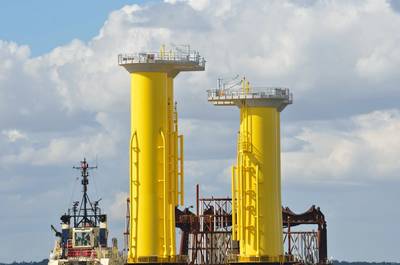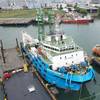Jones Act Uncertainties Persist in US Offshore Wind
The Jones Act is a single sentence long, and yet somehow that reservation of U.S. domestic maritime commerce to qualified U.S.-flag vessels has spawned numerous complications with respect to offshore wind energy projects. Although not supported by prior experience, maybe 2023 will bring some clarity.
U.S. Customs and Border Protection (CBP) is the primary source of guidance for how the Jones Act applies. CBP issued its first two offshore wind rulings in May 2010 and February 2011 in the heady early days of U.S. offshore wind. Both rulings confirmed that a foreign installation vessel could operate lawfully on U.S. projects with limitations.
Then there was a long gap where no rulings were issued until July 2020. The holdup related to offshore federal jurisdiction contained in the Outer Continental Shelf Lands Act (OCSLA). That Act applied federal law to projects relating to “resources” and it was not clear that “resources” encompassed anything more than “mineral resources” such as oil and gas. When Congress gave the federal government authority to lease the U.S. outer continental shelf (OCS) in 2005 for the purpose of producing renewable energy, it did not likewise amend the jurisdictional grant which was limited to “resources.” The ambiguity made CBP cautious, and rulings were not issued.
In January 2021 Congress amended OCSLA adding the words “including non-mineral energy resources.” Shortly after the amendment became law, CBP issued a ruling to the effect that the January amendment had changed more than merely adding renewable energy to OCSLA’s jurisdictional grant.
CBP determined that the OCSLA also extended the Jones Act to the “subsoil and seabed” of the U.S. OCS. Previously, CBP had consistently interpreted OCSLA to mean that the Jones Act – which applies to the “transportation” of “merchandise” between “points in the United States” – did not apply offshore unless, as OCSLA provides, an “installation and other device” is “attached” to the seabed for the purpose of exploring for, developing, or producing “resources.”
The context for CBP’s 2021 ruling was the transportation of rock laden in a U.S. port and unladen on the seabed for the purpose of scour protection around the base of an offshore wind tower foundation. If CBP was correct, only a qualified U.S.-flag vessel could pick up such rock in a U.S. port and deliver it to the U.S. OCS seabed even prior to any foundation installation. CBP reversed itself in March 2021 when it reverted to requiring un-ladening at a “point in the United States” on the seabed.
The same major U.S. dredging company which had sought the scour protection ruling in the first place sought to reverse the reversal via administrative appeal, which CBP denied in June 2022. That company then sued CBP in federal court in Texas in July. Until the case concludes, there will be lingering uncertainty about how the Jones Act applies to the U.S. OCS. Of course, nothing in the Jones Act prevents a foreign vessel from loading rock in Canada and placing anywhere in the United States.
Putting that aside, CBP has issued a number of rulings since early 2021 clarifying the application of the Jones Act particularly with respect to wind turbine and cable installation operations. CBP has confirmed, for example, that personnel who work on wind turbine installation vessels are all not “passengers” even if they do most of their work on towers and so can be transported by a foreign wind turbine installation vessel (WTIV) between towers. Only a qualified U.S.-flag vessel may transport “passengers” between “ports or places in the United States.”
CBP has also determined that the reusable items carried by a WTIV, such as lifting equipment and attachments, blade cassettes, containers, and tools are not “merchandise” and therefore also can be transported by a foreign WTIV between towers. CBP has long held that “vessel equipment” are not “merchandise” and the recent CBP rulings have applied that long held rule to offshore wind.
Separate litigation brought in District of Columbia federal court by an individual and two Jones Act supporting trade associations have challenged CBP’s creation of the “vessel equipment” exception and its parameters among various claims. That case also presents similar jurisdictional claims as the Texas case. The D.C. case started in 2017 and sat without progress until the middle of November 2022 when the court permitted the plaintiffs to amend their complaint. Further action, as in Texas, adds another layer of uncertainty to the application of the Jones Act to offshore wind.
There is also the possibility that the Jones Act ambit will be changed through legislation. The 117th Congress, which just ended, considered expanding U.S. manning requirements to foreign vessels working offshore which was a Jones Act expansion in every way except by name. And Rep. John Garamendi (D-Calif.) introduced legislation on December 14, 2022 entitled “Close Agency Loopholes to the Jones Act.” That legislation would also reverse the “vessel equipment” line of rulings, among other things. Whether the same or similar legislation will be reintroduced in the 118th Congress remains to be seen.
In the meantime, CBP continues to issue rulings addressing some of the questions which have arisen. For example, a number of rulings have been issued addressing the extent cable burial is “dredging,” in which case it must be undertaken by a qualified U.S.-flag vessel, or not “dredging,” in which case a foreign vessel can accomplish the mission.
None of these rulings, however, will resolve the issues in the courts. And the potential actions of the 118th Congress which began on January 3, 2023 with respect to the Jones Act are no more predictable than anything else this Congress may do. For everyone involved in the offshore wind energy industry, let us hope that at least some issues will be resolved in 2023.







